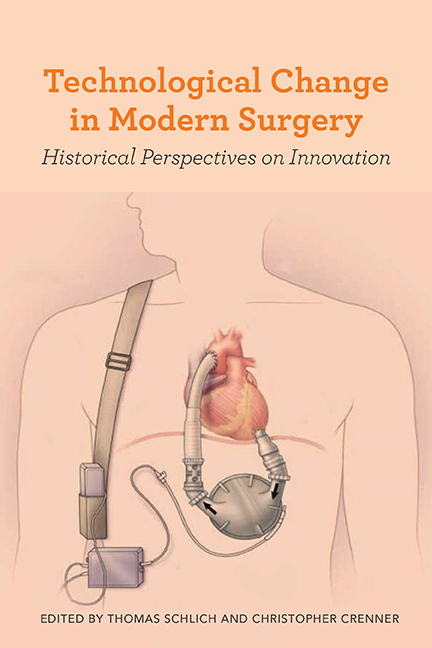Book contents
- Frontmatter
- Dedication
- Contents
- 1 Technological Change in Surgery: An Introductory Essay
- 2 Inimitable Innovation: Johann Friedrich Dieffenbach and the Renewal of Surgery, 1822–1847
- 3 Defining Difference: Competing Forms of Ovarian Surgery in the Nineteenth Century
- 4 “Making Bad Boys Good”: Brain Surgery and the Juvenile Court in Progressive Era America
- 5 Prosthetic Imaginaries: Spinal Surgery and Innovation from the Patient's Perspective
- 6 Disruptive Potential: The “Landmark” REMATCH Trial, Left Ventricular Assist Device (LVAD) Technology, and the Surgical Treatment of Heart Failure in the United States
- 7 Placebos and the Progress of Surgery
- 8 Surgical Practice and the Reconstruction of the Therapeutic Niche: The Case of Myocardial Revascularization
- Bibliography of Secondary Sources
- List of Contributors
- Index
8 - Surgical Practice and the Reconstruction of the Therapeutic Niche: The Case of Myocardial Revascularization
Published online by Cambridge University Press: 09 June 2021
- Frontmatter
- Dedication
- Contents
- 1 Technological Change in Surgery: An Introductory Essay
- 2 Inimitable Innovation: Johann Friedrich Dieffenbach and the Renewal of Surgery, 1822–1847
- 3 Defining Difference: Competing Forms of Ovarian Surgery in the Nineteenth Century
- 4 “Making Bad Boys Good”: Brain Surgery and the Juvenile Court in Progressive Era America
- 5 Prosthetic Imaginaries: Spinal Surgery and Innovation from the Patient's Perspective
- 6 Disruptive Potential: The “Landmark” REMATCH Trial, Left Ventricular Assist Device (LVAD) Technology, and the Surgical Treatment of Heart Failure in the United States
- 7 Placebos and the Progress of Surgery
- 8 Surgical Practice and the Reconstruction of the Therapeutic Niche: The Case of Myocardial Revascularization
- Bibliography of Secondary Sources
- List of Contributors
- Index
Summary
Speaking at a conference in Houston in 1985, the surgeon René Favaloro described 1968 as “the year of revolution.” He was not referring to the assassinations of Martin Luther King Jr. or Robert Kennedy or the protests against the Vietnam War. Instead, his revolution was the development of coronary artery bypass grafting (CABG) to treat coronary artery disease (CAD). For that operation, 1968 was indeed transformative. In April Favaloro published the results from his first fifty-five patients. By the summer of 1970 he and his colleagues at the Cleveland Clinic had performed CABG on over one thousand patients. Their success was matched by surgical teams in Milwaukee and New York City. Surgeons throughout the country took note. By 1977, surgeons in the United States completed over one hundred thousand CABG operations each year.
The CABG “revolution” provides an important case study of surgical innovation. Over a single decade the procedure emerged from obscurity to become one of the most common major surgical procedures. Many aspects of the innovation are interesting. First, its rise was not the result of a new discovery: Alexis Carrel had first attempted to place a bypass graft between the aorta and a coronary artery in 1910. Second, it was not the result of a lone genius, or the group at the Cleveland Clinic. Instead, researchers worldwide had tried to make Carrel's technique a success for decades, conducting extensive animal research and occasional human trials in the 1950s and 1960s. They had also developed dozens of other surgical techniques to treat CAD. Third, it was not the result of a landmark clinical trial, of the sort described by Shelley McKellar in this volume. In fact, Favaloro later downplayed the magnitude of the innovation, describing it in 1998 as a simple progression through a series of related procedures: “The evolution took place in just a few months from patch graft to interposition graft to bypass graft.”
- Type
- Chapter
- Information
- Technological Change in Modern SurgeryHistorical Perspectives on Innovation, pp. 185 - 216Publisher: Boydell & BrewerPrint publication year: 2017

